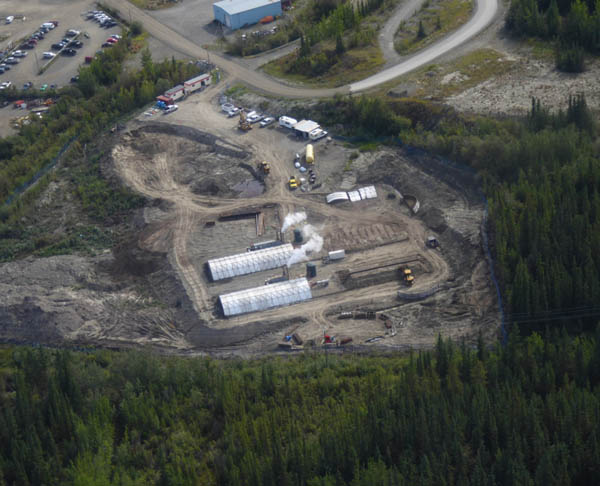Monday, June 30, 2025
Canada’s record on contaminated sites cleanups has been controversial at times. The notorious Sydney Tar Ponds in Nova Scotia comes to mind. However, it has also been impressive, as illustrated by the innovative Randle Reef project in Ontario. The main objectives of cleaning up contaminated sites is to remediate environmental impacts, reduce human health risks and prevent associated financial liabilities. But there are still so many question marks around the right course of action for the various contaminated sites existing across the country.
There are federal initiatives underway, with a growing environment sector eager to address thousands of projects from coast to coast to coast. The Federal Contaminated Sites Inventory currently lists more than 23,000 sites in various states (active, priority, suspected and closed). The Federal Contaminated Sites Action Plan was renewed in 2020 for another 15 years with $1.16 billion in funding and there are several provincial programs underway. But each province and territory have their own set of regulations, rules and standards that must be followed, which can lead to some confusion and frustration for even for the most experienced experts.
In a recent EnviroExchange discussion, our panel of industry experts shared their knowledge of innovations and evolving considerations that are supporting an increasing number of ground-breaking cleanup projects. The panel discussed who’s doing it well in terms of environmental, sustainable, and inclusive strategies across Canada as well as where shortcomings and blind spots should be addressed.
The expert panel included: Krista Barfoot, a principal of global consulting firm Stantec; Eric Pringle, managing partner and CEO of Milestone Environmental Contracting, with offices across Canada; Reanne Ridsdale, a PhD Candidate from the newly named Toronto Metropolitan University (formerly Ryerson University) who is currently based in Manitoba; and, Joanna Vince, a partner and certified specialist in environmental law from Willms & Shier Environmental Lawyers LLP in the Toronto office, but she is also licensed to practice in Northwest Territories, Nunavut and the Yukon. All are members of the Canadian Brownfields Network.

Moderator Corinne Lynds is content director at Actual Media, parent company to Environment Journal.
Unique contracting strategy
Corinne Lynds, content director at Actual Media, kicked off the dynamic discussion with a query about the project partnerships involved in the cleanup of the Hamilton Harbour’s Randle Reef — the largest remediation project in the Canadian Great Lakes. The cleanup involved legacy issues from steel manufacturing and heavy industry and has achieved impressive remediation and financing accomplishments. The project benefitted from a unique funding sharing arrangement where both government and private sector contributed funds for the cleanup, which was recognized by the Brownie Awards last year for the Reinvest category. (Brownfields are contaminated or under developed urban spaces and the Brownie Awards recognize outstanding achievement in a variety of categories.)
“One of the key aspects that made Randle Reef kind of unique is that all of that remediation, all of the materials were kept on site and handled on site,” said Prince, who explained that there were a series of unique aspects to this project. “In addition, the site was remediated with an engineered containment facility, such that the port is now able to build off that containment facility and actually create new land and new port infrastructure.”
Interestingly, the webinar poll echoed the critical need for funding solutions. When asked about the biggest barrier to cleaning up contaminated sites, the vast majority of respondent’s (69 per cent) voted for “insufficient economic incentives and financial support.”
![]()
Eric Pringle, managing partner and CEO of Milestone Environmental Contracting.
Milestone’s scope of the work, which was Phase II, included the cleanup through dredging and capping of the harbour as well as assistance in engineering the containment cell. Water management was a key aspect because as all that material was placed in the engineered cell which will be used as the foundation for the future port area. A massive volume of water had to be managed, treated and then discharged. (For more in the Randle Reef project, click here.)
How are these types of unique solutions created and carried out? Prince recommends extensive research early on to look into cost-effective strategies and best value methods. Thanks to lessons learned from 30 years in the industry, he makes it a point to bring contractors in early enough to brainstorm and collaborate in advance of any strategy decisions.
As a strategic advisor on contaminated site cleanup projects and a QP, Barfoot approaches projects in a similar way, helping clients achieve a triple bottom line of financially, environmentally and socially successful project results with careful planning at the outset.
Barfoot emphasized the importance of thinking through the “development of a site as a whole, in a really holistic way.” She pointed out that one of the biggest mistakes made in the industry is when a project is addressed in individual steps, which limits the possibility of looking for opportunities to identify cost-effective or schedule-effective redevelopment options.
![]()
Krista Barfoot, a principal at Stantec.
The main strategy she employs is to look at that overall project in that holistic mind frame and looking for opportunities to meet project objectives in a coordinated way within each component of the work.
In agreement with Prince, Barfoot points out that constructability is way too often an afterthought, but it is something that really does need to be introduced much earlier in the process so that that can also be part of that cost-effective solution.
“Within the environmental permitting process, there are decisions made within each of those stages, so be it the Phase I or the Phase II ESA, that can have really significant implications to the overall cost of the redevelopment program. So you want to make sure that you’re really thinking through each of those decisions and those stages with that long-term view and in consideration of the overall goals and the development approach.”
Otherwise, she warns, if you’re making decisions in each individual phase just to get through it as quickly as possible it’s more challenging to achieve the best possible outcome. For example, she remarked how some can be in a rush to attain their Record of Site Condition (RSC), so they get their building permit — but they risk losing the opportunity to think strategically through how the different outcomes of those phases are going to link in a way that can reduce those overall site construction costs.
Carrots and sticks
Speaking of permitting, in terms of the regulatory aspect of contaminated sites cleanup, Lynds inquired about the carrot sticks available in the current legal framework.
According to Vince, most provinces and territories have some combination of laws, regulations, and guidelines that set out the general requirements for environmental investigations and cleanups at contaminated sites.
![]()
Joanna Vince, a partner and certified specialist of environmental law at Willms & Shier Environmental Lawyers LLP.
“The requirements can vary a lot between different jurisdictions so it’s very, very important to know the rules and the requirements for where your property is located,” cautioned Vince. “Federal sites have their own rules and guidelines, and there may be even federal laws that apply even to non-federal sites. So, for example, if the site might be impacting fish through different discharges through water or groundwater, there could be Fisheries Act requirements to be aware of. Similarly, PCBs are something that’s also regulated federally and those regulations might apply if you have a PCB issue at your site.”
Using Ontario as an example, Vince explained that the Ontario Environmental Protection Act and brownfields regulations form the basis of the brownfields regime, which is then supplemented by guidelines and technical documents. The regime sets out the requirements for Phase I and Phase II environmental site assessments, including the content to be included in the reports and for example, when a Phase II might or must be completed. This framework also sets out when a cleanup or remediation to the applicable standards or risk assessment must be completed.
In Ontario, for instance, a building permit cannot be issued by the municipal chief building official if there’s a change to a more sensitive use until the landowner obtains a RSC under the brownfields framework. The record certifies that the property either meets the standards or that there’s a risk assessment that’s been accepted by the Ministry of Environment, Conservation and Parks that documents no risk to human health or to ecology.
“Several of the brownfield frameworks across Canada provide a record or a certificate or a letter on completion of the cleanup that not only certifies that the properties clean, which is important for restoring value to property in some cases, but it also provides some protection from liability,” said Vince. The RSCs (the carrots) provide the owners and all subsequent owners of the property with limited protection from ministry orders (the sticks).
On the one hand, the RSC provides peace of mind but on the other hand there’s been an expansion of order powers over the past decade.
“It doesn’t matter that three owners before you caused the contamination or worse. You could be responsible for it,” warns Vince. “We’ve seen directors and officers of owners and occupiers be ordered, subsequent property owners and occupiers who had no control or did not cause the contamination.”
Emerging issues
As an aside from sort of this legal framework that exists across the provinces and territories and federally within Canada, there’s also sort of emerging policies and other areas that promote the redevelopment of contaminated sites, so cleanup of contaminated sites.
There was a consensus across the panel about the importance of Environmental, social governance (ESG) considerations and how the potential for making a positive impact on the environment and on social aspects and society. Contaminated properties can fit within that ESG framework and redeveloping them as part of a portfolio or as part of business operations can really feed into their ESG criteria and help access financing and funding that might not otherwise be available.
![]()
Reanne Ridsdale, PhD Candidate at Toronto Metropolitan University.
Ridsdale is particularly primed to speak on addressing ESG with her extensive academic research on environmental racism and cleaning up contaminated sites as an opportunity to address environmental racism and the legacy of structural inequality and provide energy sovereignty to indigenous communities.
What exactly is environmental racism? Ridsdale defined it as the unequal protection of and the disproportionate exposure of hazardous materials on racialized individuals.
“Environmental racism is a form of state sanctioned racial and gender violence through which violent control over indigenous and racialized bodies, space and knowledge systems work to harm the economic, political and social wellbeing of these communities. So, the predominant institutional rules, regulations and policies of government or corporate decisions that deliberately target certain communities for least desirable land uses resulting in the disproportionate exposure of toxic and hazardous waste on communities based on biological characteristics,” explained Ridsdale.
According to research from the U.S., Black and Indigenous people and people of colour communities are exposed to 60 per cent more pollution than they consume — whereas whites are exposed to less pollution than what they consume. She estimates it’s quite similar to the Canadian context. She pointed to Canadian examples of the Pictou Landing First Nation in Nova Scotia, Fort McKay in Alberta north of the Athabasca tar sands, Grassy Narrows in Ontario and the Aamjiwnaang First Nation in Chemical Valley or Sarnia in Ontario. Looking specifically in Indigenous communities on reserves, Ridsdale said there’s a staggering 1,979 contaminated sites out of 2,300 reserves.
“So it’s clear that there’s a disproportionate amount of brownfields and contamination in minority neighborhoods, but then there’s also a disproportionate amount of public money that’s being spent in richer neighborhoods,” she pointed out.
Ridsdale argues that if the government would stimulate economic growth through brownfields in marginalized communities, we’d get a better return on public money. As important as it is to think of the social justice or the environmental justice aspects, there’s also a case to be made for better policy spending and stimulating communities that actually need it.
“When we talk about environmental justice, it simply means embracing the principle that all people in communities are entitled to equal protection of environmental health, employment, housing, transportation, civil rights law,” said Ridsdale.
Building on the themes of environmental justice and social justice energy sovereignty would mean, for example, implementing green energy into contaminated sites, especially communities that have suffered disproportionate burden. According to Ridsdale, careful and thoughtful brownfields redevelopment can help close the gap.
Vince concurred and highlighted the opportunities of financing and funding that are now being made available to the private sector through banks and others through green funds, blue funds, ESG funds or sustainable funds that can help make these projects more affordable or viable.
She noted this is one way that proactive companies can bump up their ESG scores and partner with First Nations communities. The other way, unfortunately, is through litigation and especially where it’s an outside source that’s caused the contamination. Either way, it’s an important issue that must be addressed.
“What drives contaminated sites development is often good policy and good regulation, a good framework that actually allows it to propel itself forward,” offered Barfoot, who added that expanded brownfield incentive programs could help stimulate more contaminated site redevelopment, in municipal and federal levels of government.
Once again, the webinar poll reflected this sentiment, indicating that the second biggest barrier to cleaning up contaminated sites is “weak environmental policy and legislation.”
The panelists also pointed to the potential of public/private partnerships to play a greater role in addressing larger contaminated sites that are associated with significant infrastructure work. However, they also mentioned the importance of tackling both large and smaller — but still significant — projects. Some of the smaller towns have complex legacy issues and some of the remote sites such as abandoned mine sites also need addressing across Canada.

Milestone Environmental Contracting partnered with Iron Creek Group Inc. to complete a large-scale remediation project for the Yukon Government at the Marwell Tar Pit site located in Whitehorse. This was the largest single-source hydrocarbon contaminated site in the Yukon. For further information about this project, click here. Credit: MEC.
They cited Ontario as an example of a supportive system, with its designated areas in urban spaces that can tap into extra brownfield funding and incentives in targeted community areas. This concept could be extended to many other urban spaces, as well as rural and remote spaces. The absence of strong federal policy seems to be an ongoing detriment to brownfields redevelopment.
Evolved policy and regulations would help propel progress. Ridsdale pointed to Parliament’s recent tabling of Bill C-226, an Act respecting the development of a national strategy to assess, prevent and address environmental racism and to advance environmental justice. She hopes that brownfields will get a big boost from this legislation.
Contaminated mountain to climb
Contaminated sites project teams need all the help they can get. Vince emphasized the challenges of addressing that aren’t in urban centres, such as remote mining sites in Northern Canada. The remote locations and long distances for experts and equipment to travel can make the cleanup project very difficult and very expensive.
The most recent federal budget provides an investment of $357 million over the next five years to reclaim contaminated areas and rehabilitate land, to stimulate the energy transition and support sustainable practices. But what is the best way for motivated industry stakeholders to mobilize these funds?
Barfoot said this might be a place that corporations could look to their own ESG practices, policies, and targets and see how they can be achieved through these types of contaminated site projects. So it could be the metrics that are associated with accessing those funds are similar to the metrics that get established for ESG programs corporately. So, perhaps looking to demonstrate some alignment in those practices might be something that would help them access that funding.
However, Ridsdale cautions that while the investments seem great on the surface, we should be looking more specifically into addressing First Nations communities and ways to generate income through, for example, green energy systems. She also emphasized that “building better is not just putting that Starbucks with the condos, it’s putting in green spaces and trees, places for us to walk. We’re just coming out of a pandemic where we really value the outside space.”
But how can more holistic projects cut through the red tape inherent in contaminated site redevelopment? It’s complicated, concedes Vince, as every province and every territory has its own legislation, with its own framework. There are similarities between some of them, with some of them being more complex, and some more straightforward, some rely more on the consultant’s discretion, some are more regulated.
“We could have a who-has-got-it-worse competition between the different provinces and territories, but I think, the reality is it is very project specific and at the end of the day, every jurisdiction does have its own challenges in getting projects done and brownfields redeveloped,” she says. “Nothing’s perfect, but everything, to some extent, is working because we are getting sites cleaned up across the country.”
Prince’s perspective is similarly realistic but optimistic. “There’s so much difference with each project, and it can be daunting for owners and people that want to bring projects forward. It’s not for the faint of heart.” Yet he also pointed out that the future is bright with many of the different provinces coming on board with brownfield focused groups within their regulatory environment, which has increased over the last decade and is making everything more efficient.
Looking to the future, are there guidance documents to prevent contamination at industrial sites and sustainable practices to avoid site contamination?
Vince said that environmental management acts play a large part in prohibitions on discharges, prohibitions on spills, requirements to immediately clean up spills, clean up discharges, report to the regulators so that they can ensure they have someone out there to see what happened, evaluate, make sure that what’s being done is right and then reporting back once the cleanup is done.
She also pointed to approvals and permitting for air emissions, water discharges, and wastewater discharges to ensure that the range of activities meet various affluent criteria or emissions criteria to reduce future contamination, such as spill response procedures and making sure employees are adequately trained for due diligence. “But the reality is that things happen, pipes break, employees go rogue. We’ve seen it all.”
Barfoot added that there’s also engineering controls to consider and that these get built into projects as best industry practice. You’ll see, often, secondary containment systems, you’ll see the protective barriers around things. So there’s a lot of engineering that can also go into helping to reduce the possibility of those kind of accidents and releases as well.
Lastly, Lynds prompted some interesting final comments. In the future, whether it’s new legislation or new budgets, what is it going to take for us to be prepared for accelerated cleanup and redevelopment?
From Barfoot’s perspective, communicating awareness about the green economy and the specific roles needed in the workforce is key. “There is purposeful, valid and work that can sustain and support [the next generation]” she said. “I think we need to be really kind of purposely trying to emphasize drawing in the next gen of innovators, because that’s who’s going to help us solve these problems going forward.”
Vince echoed this sentiment. “I spend a lot of time talking to undergrad students and law students about what I do. The educational component for the general public, for students coming up and also with governments and policy makers to say, “We need to support this. And we need funding for researching innovative strategies to remediate these worst of the worst sites so that we can get it done and we can get it done economically and we can put them back into use.” So stronger policy that supports that funding, but also supports getting this done in a reasonable way that is cost efficient.
According to Ridsdale, redeveloping contaminated sites can help address a variety of current challenges — inequalities and energy dependence that is leading to an apocalyptic climate change, urban sprawl, and insufficient environmental protection.
Pringle suggested a few solutions. Innovation: keep looking at new ways of doing things (such as in situ and better ex situ options) rather than doing things the old way (trucking material to be landfilled). Connecting with diverse perspectives and new people because the next gen can infuse an organization with new ideas and refreshing perspectives. Finally, the need for collaboration to come up with shared solutions that make a difference.
With that in mind, we’re now aware that whether it’s for economic reasons, environmental motivations or to address social justice — or all of the above — there are innovative and resourceful ways to clean up contaminated sites in Canada, and 23,000 sites on the to do list.
The webinar, which was sponsored by Milestone Environmental Contracting, can be viewed in its entirety, here.
To help recognize outstanding achievement in brownfields redevelopment, nominate a project, program or person for the 2022 Brownie Awards. For further information, click here.
For further information on upcoming EnviroExchanges, visit:
Featured image: The partners involved in the cleanup of Randle Reef — the largest remediation project in the Canadian Great Lakes — recently announced the completion of Stage 2 of the contaminated sediment remediation which is removing over a century of contamination from Hamilton Harbour. Credit: Government of Canada.











